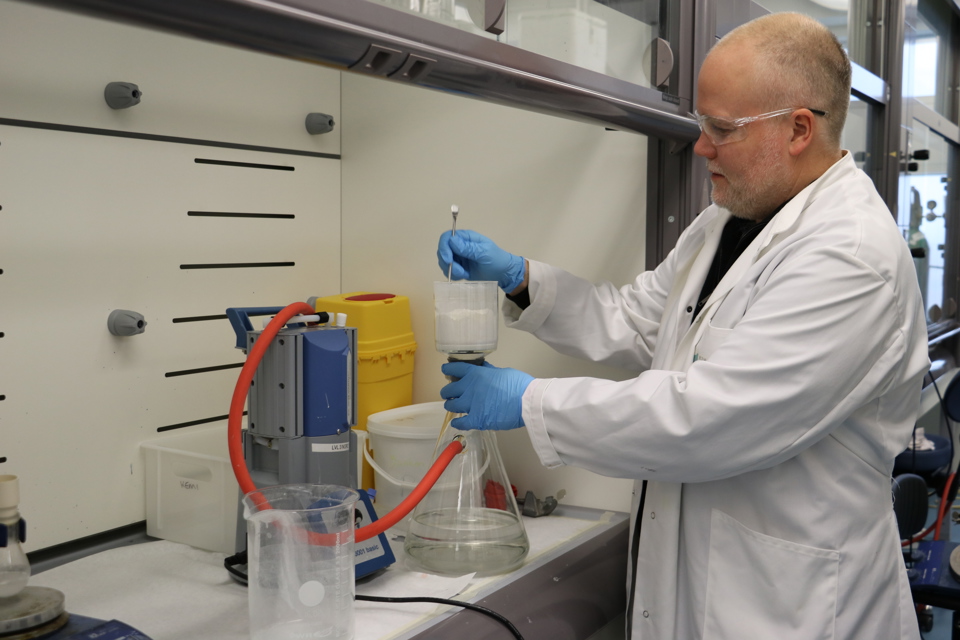This thorough research into a wide range of properties and applications of cyclodextrins is in part facilitated by Aalborg University’s problem-based learning model where groups of students can aid the researchers in their work. “The chance to have students working on this with us gives us the opportunity to try out a wider range of things than if we ourselves were to perform all the experiments. We can ask the students, “We have this idea, will you test it in a project?” And that will give us an indication of whether or not to pursue that line of thinking – and that path of research” Kim Lambertsen Larsen says.
Cyclodextrins improve the effect of medicine
One field that has a long history of utilizing the properties of cyclodextrins is medicine. Here, the cyclodextrins are used as an inert excipient facilitating efficient delivery of drugs, but recently also as a medicine in themselves.
- “When we get medicine in tablet form, these are swallowed and will dissolve in the stomach and digestive system. The speed with which the medicine is absorbed in the colon depends on the speed with which the tablet dissolves. First the solid tablet needs to disintegrate into small crystals of the medicine, and then these crystals need to dissolve so that the medicine can be absorbed by the body. The dissolution of the medicine in crystalline form and the intrinsic solubility of the medicine is usually fairly low, which are the main reasons that some medicines have poor bioavailabilities” Kim Lambertsen Larsen explains. If, however, cyclodextrins are added to the mix that makes up the tablet, the medicine will form complexes with them, and the dissolution rate of the tablet will increase markedly.
“This enables us to absorb the medicine faster and more efficient because the medicine dissolves more quickly in our digestive system or even in a glass of water before we take it – think, for instance, of the way TREO or Panodil Zapp works” Kim Lambertsen Larsen adds.
The faster dissolution of the tablets increases the concentration of medicine in the colon, which again increases the speed with which the medicine is absorbed through the colon membrane and into the bloodstream – and as such the speed with which it takes effect.
From excipient to actual medicine
In recent years, the use of cyclodextrins in medicine has been extended to utilizing their ability to bind other molecules for medicinal purposes: “Cyclodextrins have proved to be very, very good at binding cholesterol. This means that it is now possible to remove cholesterol by injecting cyclodextrins straight into the brain of a patient suffering from Niemann-Pick type C disease and improve that patient’s cholesterol balance. Even more, recent studies have shown that cyclodextrins may be used for the treatment of atherosclerosis, the most common cardiovascular disease and one of the most common causes of death worldwide. Here, the cyclodextrins simply dissolve the cholesterol crystals and reduce the atherosclerotic plaques” Kim Lambertsen Larsen explains and adds:
- “In addition, they are now used as an antidote to counteract the effects of certain types of muscle relaxants that are used during surgeries or endoscopies where the patient needs to have a tube down his or her throat. Earlier, the after effects of the muscle relaxant would last for maybe half an hour, but now the patient gets an injection of cyclodextrins tailored to the removal of this specific medicine from the bloodstream, and the recovery period is down to two minutes.”
Inventing new uses of cyclodextrins
The use of cyclodextrins has also moved into a variety of other industrial fields. One of the most well-known examples is the odor remover Febreze that utilizes cyclodextrins for binding the molecules that make clothes or dog baskets smell unpleasantly. Kim Lambertsen Larsen has, together with former students, invented a new way of applying cyclodextrins’ properties: Using cyclodextrins as coating for surfaces which can then be used to either absorb or release molecules to the surroundings. The technology is currently on the verge of being commercialized.

